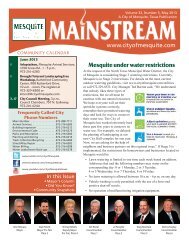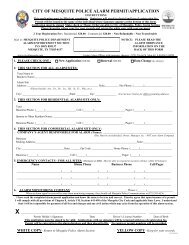airport/documents/Mesquite Master Plan Final.pdf - The City of ...
airport/documents/Mesquite Master Plan Final.pdf - The City of ...
airport/documents/Mesquite Master Plan Final.pdf - The City of ...
You also want an ePaper? Increase the reach of your titles
YUMPU automatically turns print PDFs into web optimized ePapers that Google loves.
translate into point-to-point guidance<br />
and position information. <strong>The</strong> types <strong>of</strong><br />
electronic navigational aids available<br />
for aircraft flying to or from <strong>Mesquite</strong><br />
Metro Airport include non-directional<br />
beacon (NDB), very high frequency<br />
omni-directional range (VOR) facilities,<br />
global positioning system (GPS), and an<br />
instrument landing system (ILS).<br />
<strong>The</strong> NDB transmits nondirectional<br />
radio signals whereby the pilot <strong>of</strong> an<br />
aircraft equipped with direction-finding<br />
equipment can determine the bearing to<br />
or from the NDB facility in order to<br />
track to the beacon station. <strong>The</strong><br />
<strong>Mesquite</strong> NDB is 3.7 nautical miles<br />
(nm) to the north <strong>of</strong> Runway 17-35. <strong>The</strong><br />
Jecca NDB is four nm south <strong>of</strong> the<br />
runway. Other NDBs in the vicinity <strong>of</strong><br />
the <strong>airport</strong> include Lancaster (14 nm),<br />
Travis (14.2 nm), Redbird (17.7 nm),<br />
Caddo Mills (22.6 nm), Cedar Hill (24.4<br />
nm), and Cash (27.3 nm), as depicted on<br />
Exhibit 1D. <strong>The</strong> <strong>City</strong> <strong>of</strong> <strong>Mesquite</strong><br />
owns and maintains both the <strong>Mesquite</strong><br />
and Jecca NDB facilities. <strong>The</strong> Redbird<br />
and Cedar Hill facilities are maintained<br />
by the FAA. <strong>The</strong> other regional NDB<br />
facilities are maintained by the local<br />
jurisdictions.<br />
<strong>The</strong> VOR, in general, provides azimuth<br />
readings to pilots <strong>of</strong> properly equipped<br />
aircraft by transmitting a radio signal<br />
at every degree to provide 360<br />
individual navigational courses.<br />
Frequently, distance measuring<br />
equipment (DME) is combined with a<br />
VOR facility (VOR-DME) to provide<br />
distance as well as directional<br />
information to the pilot. Military<br />
tactical air navigation aids (TACANs)<br />
and civil VORs are commonly combined<br />
to form a VORTAC. <strong>The</strong> VORTAC<br />
1-13<br />
provides distance and directional<br />
information to both civil and military<br />
pilots. <strong>The</strong> Cowboy VOR/DME is 20.7<br />
nm to the northwest <strong>of</strong> the <strong>airport</strong>. <strong>The</strong><br />
Maverick VOR/DME is 26.7 nm to the<br />
west at Dallas/Fort Worth International<br />
Airport. <strong>The</strong> Ranger and Cedar Creek<br />
VORTACs are within 40 nm <strong>of</strong> the<br />
<strong>airport</strong>. Each <strong>of</strong> these facilities are<br />
owned and maintained by the FAA.<br />
GPS is an additional navigational aid<br />
for pilots. GPS was initially developed<br />
by the United States Department <strong>of</strong><br />
Defense for military navigation around<br />
the world. GPS differs from a NDB or<br />
VOR in that pilots are not required to<br />
navigate using a specific facility. GPS<br />
uses satellites placed in orbit around<br />
the earth to transmit electronic radio<br />
signals which pilots <strong>of</strong> properly<br />
equipped aircraft use to determine<br />
altitude, speed, and other navigational<br />
information. <strong>The</strong> network <strong>of</strong> 24 GPS<br />
satellites is maintained by the U.S.<br />
military.<br />
With GPS, pilots can directly navigate<br />
to any <strong>airport</strong> in the country and are<br />
not required to navigate using a specific<br />
navigation facility. <strong>The</strong> FAA is<br />
proceeding with a program to gradually<br />
replace all traditional enroute<br />
navigational aids with GPS over the<br />
next few years. <strong>The</strong> completion <strong>of</strong> the<br />
FAA phase-out schedule for traditional<br />
navigational aids is planned to occur by<br />
2010. Most navigational aids<br />
supporting busier <strong>airport</strong>s will be<br />
retained.<br />
<strong>The</strong> ILS is a approach and landing aid<br />
designed to identify the exact alignment<br />
path <strong>of</strong> an aircraft. ILS systems are<br />
installed to allow approaches during




